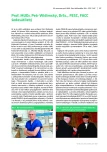30 years heart transplantation program in Institute for Clinical and Experimental Medicine in Prague
Authors:
Lenka Hošková 1; Ivan Málek 1; prof. MUDr. Vojtěch Melenovský, CSc. 1; Marianna Podzimková 1; Markéta Hegarová 1; Zora Dorazilová 1; Josef Kautzner 1; Ivan Netuka 2; Jan Pirk 2
Authors‘ workplace:
Klinika kardiologie Institutu klinické a experimentální medicíny Praha, přednosta prof. MUDr. Josef Kautzner, CSc.
1; Klinika kardiovaskulární chirurgie Institutu klinické a experimentální medicíny Praha, přednosta prof. MUDr. Jan Pirk, DrSc.
2
Published in:
Vnitř Lék 2014; 60(4): 275-281
Category:
60th Birthday - prof. MUDr. Petr Widimský, DrSc., FESC, FACC
Overview
Heart transplantation has become in recent decades an established method for the treatment of advanced heart failure. Precisely, it was in January 2014 when 30 years have passed since the start of clinical heart transplantation program at the Institute for Clinical and Experimental Medicine. 936 heart transplants were performed by the end of 2013. The transplant program has reached considerable development since its beginnings. The knowledge of whole issue has deepened, indication criteria have been extended, new immunosuppressives are available and many of them are still in research. Life expectancy of patients has been prolonged and quality of life has improved. Nevertheless, the care of transplant patient is very complicated task for medical professionals and brings a lot of problems to solve.
Key words:
donor heart – graft rejection – heart transplant – immunosuppression – indication criteria – selection of patients
Sources
1. Kočandrle V, Fabián J, Firt P. Transplantace srdce. Čas Lék Čes 1984; 123(43): 1297–1302.
2. Pirk J, Málek I et al. Transplantace srdce. Karolinum: Praha 2008. ISBN-13: 978–80–246–1606–3.
3. Lund LH, Edwards LB, Kucheryavaya AY et al. The Registry of International Society for Heart and Lung Transplantation: thirtieth official adult heart transplant report- 2013; focus theme: age. J Heart Lung Transplant 2013; 32(10): 951–964.
4. Pokorná E. Zemřelí dárci orgánů, právní normy diagnostiky smrti mozku. Přehled dárců a transplantací jater v České republice. Vnitř Lék 2013; 59(8): 678–681.
5. Málek I. Indikace k transplantaci srdce. Cor Vasa 2008; 50(3): 129–132.
6. Špinar J, Vítovec J, Hradec J et al. Doporučený postup České kardiologické společnosti pro diagnostiku a léčbu chronického srdečního selhání, 2011. Cor Vasa 2012; 54(3–4): 161–182.
7. Špinarová L. Transplantace srdce – minulost, současnost a výhled do budoucna. Vnitř Lék 2010; 56(8): 884–888.
8. Reichenbach A, Al-Hiti H, Malek I et al. The effects of phosphodiesterase 5 inhibition on hemodynamics, functional status and survival in advanced heart failure and pulmonary hypertension: a case-control study. Int J Cardiol 2013; 168(1): 60–65.
9. Melenovsky V, Al-Hiti H, Kazdova L et al. Transpulmonary B-type natriuretic peptide uptake and cyclic guanosine monophosphate release in heart failure and pulmonary hypertension: the effects of sildenafil. J Am Coll Cardiol 2009; 54(7): 595–600.
10. Kettner J, Dorazilová Z, Netuka I et al. Is severe pulmonary hypertension a contraindication for orthotopic heart transplantation? Not any more. Physiol Res 2011; 60(5): 769–775.
11. Hošková L, Pagáčová L, Slavčev A et al. Heart transplantation in a highly sensitised patient. Kardiol Pol 2011; 69(1): 51–53.
12. Hunt J, Lerman M, Magee MJ et al. Improvement of renal dysfunction by conversion from calcineurin inhibitors to sirolimus after heart transplantation. J Heart Lung Transplant 2005; 24(11): 1863–1867.
13. Raichlin E, Bae JH, Khalpey Z et al. Conversion to sirolimus as primary immunosuppression attenuates the progression of allograft vasculopathy after cardiac transplantation. Circulation 2007; 116(23): 2726–2733.
14. Janek B. Role endomyokardiální biopsie v současnosti – editorial. Interv Akut Kardiol 2013; 12(3): 112–114.
15. Hošková L, Viklický O, Málek I et al. Ischaemic heart disease is a risk factor for renal failure after heart transplantation. Int J Cardiol 2008; 123(3): 358–360.
16. Hunt J, Lerman M, Magee MJ et al. Improvement of renal dysfunction by conversion from calcineurin inhibitors to sirolimus after heart transplantation. J Heart Lung Transplant 2005; 24(11): 1863–1867.
17. Kobashigawa JA, Katznelson S, Laks H et al. Effect of pravastatin on outcomes after cardiac transplantation. N Engl J Med 1995; 333(10): 621–627.
18. Skalická B, Kubánek M, Málek I et al. Conversion to tacrolimus and atorvastatin in cyclosporine-treated heart transplant recipients with dyslipidemia refractory to fluvastatin. J Heart Lung Transplant 2009; 28(6): 598–604.
19. Kocík M, Málek I, Janek B. Risk factors for the development of coronary artery disease of a grafted heart as detected very early after orthotopic heart transplantation. Transpl Int 2007; 20(8): 666–674.
20. Kauffman HM, Cherikh WS et al. Maitenance immunosuppression with target of target-of-rapamycin inhibitors is associated with reduced incidence of de-novo malignancies. Transplantation 2005; 80(7): 883–889.
21. Alberú J, Pascoe MD, Campistol JM et al. Lower malignancy rates in renal allograft recipients converted to sirolimus-based, calcineurin inhibitor-free immunotherapy: 24-month results from the CONVERT trial. Transplantation 2011; 92(3): 303–310.
Labels
Diabetology Endocrinology Internal medicineArticle was published in
Internal Medicine

2014 Issue 4
Most read in this issue
- Liver in heart failure
- Right ventricle in severe pulmonary hypertension in congenital heart defects – different and specific.
- Operation of Ebstein anomaly in adulthood – our experience
- Mitral stenosis
